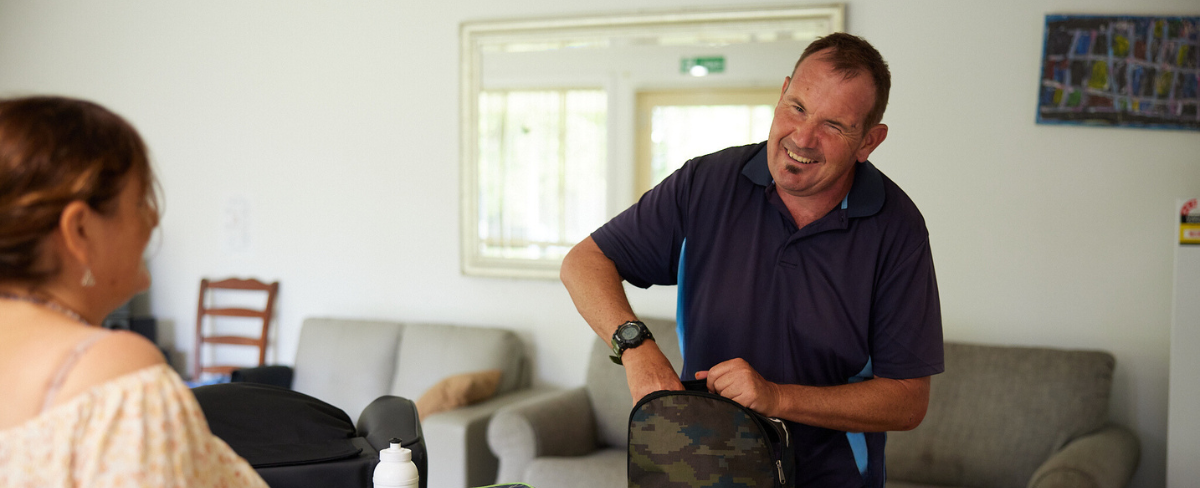Supported Independent Living (SIL) and Specialist Disability Accommodation (SDA) are key terms used within the NDIS to describe essential accommodation supports for people living with disability. Although these terms are often mentioned together, they represent different types of funding and services that work hand in hand to help individuals live independently.
SIL and SDA are separate terms coined by the National Disability Insurance Agency (NDIS) to describe funding streams that support NDIS participants. Supports that are often delivered in tandem.
Think of Supported Independent Living (SIL) as the ‘how’—the daily supports that enable independence—and Specialist Disability Accommodation (SDA) as the ‘home’ —accessible housing designed for people with high support needs.

What is Supported Independent Living (SIL)?
The purpose of SIL is in the name! Supported Independent Living is support for people living with disability to live as independently as possible. These services can be delivered in the family or private home but are typically delivered in homes shared with other NDIS participants.
- Assistance with daily living tasks
- Household support
- Development of life skills
- Community access
- Health and wellbeing support
- Support for behavioural needs
While SIL services can be delivered in private homes, or with family, they are commonly provided in shared living environments or Specialist Disability Accommodation (SDA) homes. This is why you often find these services mentioned at the same time.
What is Specialist Disability Accommodation (SDA)?
Specialist Disability Accommodation (SDA) refers to homes fitted with accessible and innovative features that help residents live more independently, in safety. SDA funding is designed for people with high support needs and functional impairment.
There are 4 types of SDA
- Improved Livability: Accessible home features for people with intellectual, cognitive and sensory impairment, such as tactile highlights on walls and doors for vision impairment
- Robust: Highly resilient homes with features such as secure windows and high impact fittings, designed to keep residents with behavioural needs, and their carers, safe.
- Fully Accessible: Homes with high level of physical support for people with significant functional impairment, such as wheelchair access
- High Physical Support: Similar to Fully Accessible, but including features such as structural provisions for ceiling hoists, voice control assistance and emergency power solutions.
Brad’s Story

About 5 years ago, I had an accident which changed my life, leaving me non-verbal and with a brain injury. After the recovery process I lived at home by myself, supported by Support Workers. I was lonely, not reaching my goals and having a really difficult time. After connecting with Ability Options SIL and SDA services I was able to rebuild my life. I worked with physiotherapists to improve my strength and communication, allowing me to start doing the things I love again. Now, I am learning to steer and control my wheelchair myself and get out in the community with my Support Workers so I can meet people my age and make new friends.
Quick FAQs
- What is the difference between SIL and SDA?
SIL provides daily support services, while SDA refers to accessible housing designed for individuals with high needs. - Who is eligible for SIL and SDA funding?
SIL and SDA funding are available to NDIS participants with assessed needs. An Allied Health Professional will conduct a functional assessment to determine eligibility. - What types of supports are included in SIL services?
SIL services include assistance with daily living tasks like cooking, cleaning, and personal care, as well as support for health and wellbeing, community access, life skills development, and managing behavioral needs. - Can I access SIL services without living in an SDA home?
Yes, SIL services can be provided in a family home, private residence, or other non-SDA shared home settings. However, many NDIS participants choose to access SIL in shared homes or SDA homes for additional support and community engagement. - How long does it take to access SDA housing?
The process of applying for SDA funding and transitioning into a home can take up to 12 months. This involves a functional assessment, eligibility determination, and finding the right housing option to meet your needs.
Getting Started
To access Supported Independent Living (SIL) or Specialist Disability Accommodation (SDA) services through providers like Ability Options, you’ll need a NDIS Plan that includes funding for SIL or SIL + SDA.
- Supported Independent Living is funded under Core Supports – Assistance with Daily Life
- Specialist Disability Accommodation is funded as a Capital Support
To determine your eligibility, an Allied Health Professional will undertake a functional assessment.
Applying for SIL/SDA can take time, so if you don’t have these funding streams, it is a good idea to start engaging with your Local Area Coordinator and Support Coordinator.
Why Choose Ability Options?
At Ability Options, supporting people living with disability is at the heart of everything we do. As a recognised sector leader in disability accommodation services and Registered NDIS Provider, we’re committed to empowering you. Our expertly trained teams deliver superior quality of life outcomes, supported by robust best practice frameworks.
We will guide you and help you to access and transition into SIL and SDA services, creating a lifestyle where you feel at home.
If you have SIL or SIL + SDA funding in your NDIS Plan, contact one of our friendly Accommodation Occupancy Coordinators today or check out our available supported living homes.


